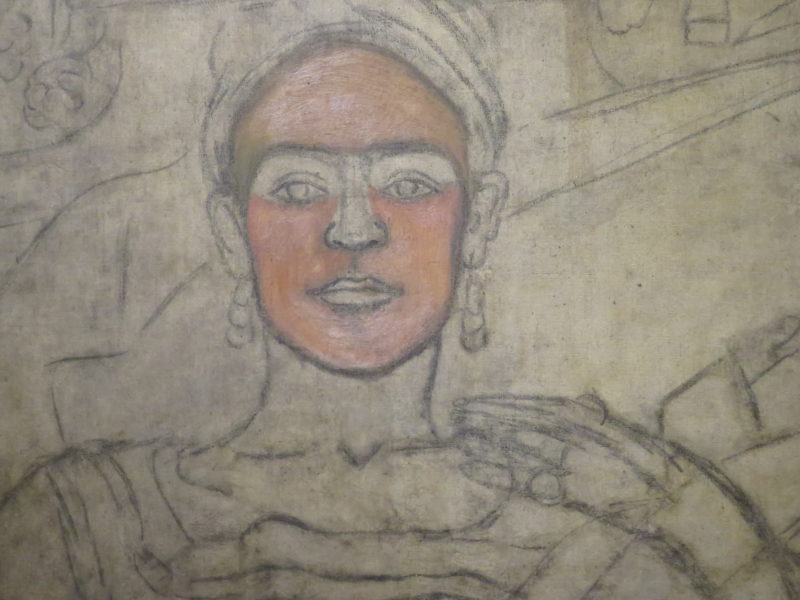
 About 100 years ago I had my heart broken by someone born in Mexico who happened to be a Frida Kahlo fan. As a consequence I ignored all things Frida until I went to see her house, Casa Azul, in Coyoacán last week. Lingering bits of resentment, perhaps, colored my initial impression of her, surrounding herself with 40 dolls made all in her likeness in her bedroom. How could that not be the sign of a raving narcissist?
About 100 years ago I had my heart broken by someone born in Mexico who happened to be a Frida Kahlo fan. As a consequence I ignored all things Frida until I went to see her house, Casa Azul, in Coyoacán last week. Lingering bits of resentment, perhaps, colored my initial impression of her, surrounding herself with 40 dolls made all in her likeness in her bedroom. How could that not be the sign of a raving narcissist?

Ambling through the – beautiful – compound, looking at the environment she created, the pictures she hung and reading about her life history in front of the various exhibits soon replaced that assessment with a sense of shame of being so judgmental – the woman had such horrific experiences, such fragile health compromised by disease and disastrous accidents, surely the dolls where an expression of the need to live on?

Her death mask placed there by her mother, I believe. The one who was never really there for her….

Over her bed

The kitchen Sculptures in the garden
Sculptures in the garden
Parents
I started to read up on Kahlo, and strongly urge you to check out this recent article that implies a much more complex and layered picture.
http://www.vanityfair.com/culture/1995/09/frida-kahlo-diego-rivera-art-diary
She was not well; not just in the physical sense of having survived polio, and a traffic accident that destroyed spine and pelvis; she suffered from Munchhausen Syndrome, the psychological state of attention seeking through lying around medical issues. Her childhood history predisposed her to associate pain with feeling loved. In addition she had sexual appetites matching that of her husband, in her case with an openly bisexual orientation. She lived for being photographed, not just after she’d gained a certain amount of fame and notoriety.

She was a gifted artist, a pathbreaker, in some ways, for feminist demands, and capable of immense love, first and foremost for Diego Riviera.


Her house provides lots of food for thought, including an exhibit of her clothes that points to an ingenious and defiant bit of design creativity emphasizing her body’s disfigurations rather than hiding them.




Her teeth, ravaged from a daily bottle of brandy, smoking and a diet of sugary foods, where replaced by gold dentures – and, for special occasions, some studded with diamonds. In some ways she made herself, the physical presence of herself, into works of art, with color, fabric, props, created something that could be caught on camera and thus s u r v i v e, when she knew that she wouldn’t. She died at age 47.

If you are still longing for more, here is NYT bit that links you to various publications. Attachment is in the picture,
And I cite: “In under two decades, aided by a well-regarded biography and a soapy biopic, Kahlo had undergone transformation from a compelling cult figure to a universally recognized symbol of artistic triumph and feminist struggle. Somehow along the way she also became a centerpiece of a kitsch marketing bonanza. The “Fridamania” that elevated Kahlo to near-mythic dimensions also transformed her — brooding gaze, elaborate Tehuana coiffures, signature mono-brow — into an image emblazoned on sneakers, T-shirts, tote bags, coasters, cosmetics, even tequila and beer.”
If you want to visit the famous blue house make sure you get tickets on-line well beforehand. Otherwise you’re caught in a queue. I hear that a much better selection of her art can be found in a private collection that some years back opened to the public. On my list for the next visit!







Bob Hicks
My friend Penelope Hunter-Stiebel curated a show of photographs of Frida that’s at the Spanish Colonial Museum in Santa Fe right now. You two would like each other. http://spanishcolonial.org/exhibits/